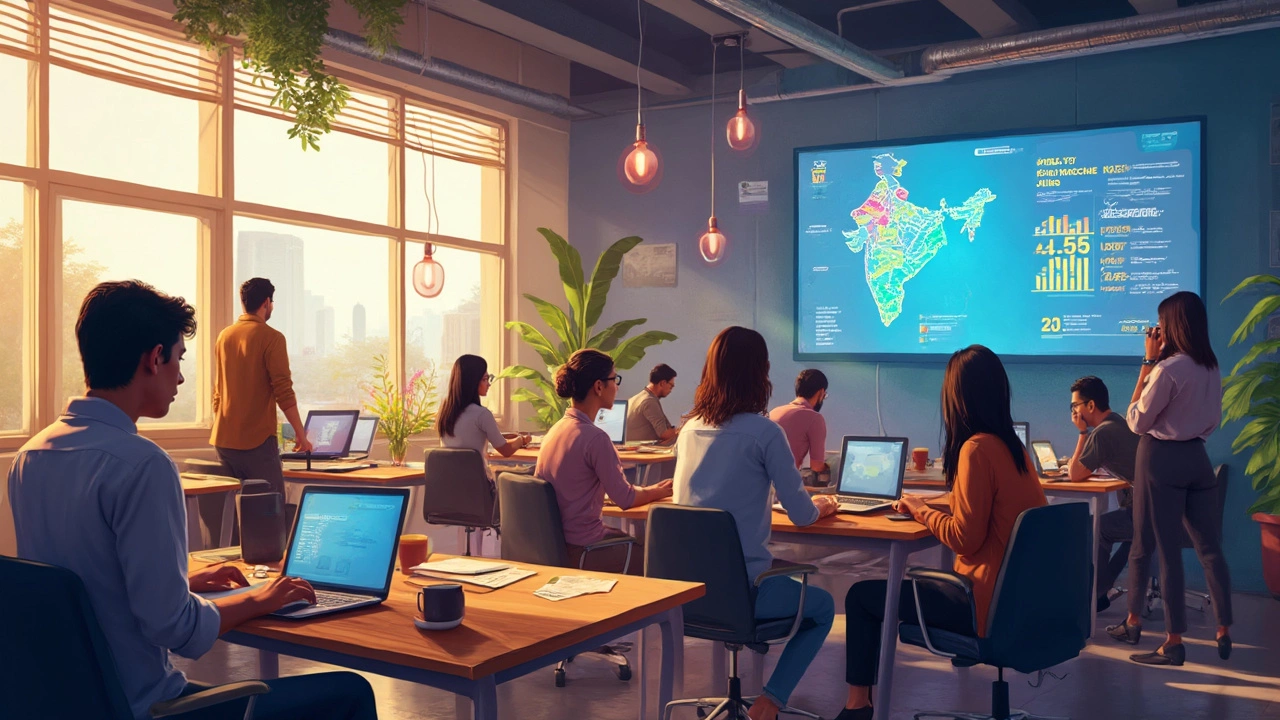Ever wondered if you could skip learning to code and still earn a solid paycheck? No code jobs are blowing up, and the pay is a lot better than most people think. In 2025, folks are hustling up impressive incomes just by building apps, automations, or even full websites—all without touching a single line of traditional code.
Here's the deal: No code isn't about 'slacking off' or doing easy work. It's about using smart tools like Webflow, Zapier, or Bubble to create real products for real businesses. Plenty of people are getting full-time roles, freelancing, or running their own agencies, all riding the no code wave. Wondering what the money actually looks like? Let’s break down the numbers, what's driving salaries, and how you can cash in on the trend—no computer science degree needed.
- What Counts as No Code Work?
- Average Salaries and Common Ranges
- Top Platforms and Where the Money Is
- What Shapes Your Earnings?
- How to Boost Your No Code Income
What Counts as No Code Work?
Let’s get clear—when people say no code, they mean building legit stuff without using actual programming languages like Python or JavaScript. Instead, you use drag-and-drop tools and platforms. But make no mistake, the results aren’t amateur. Lots of real businesses run off of no code solutions.
Here’s what usually falls under no code work:
- Website building: Platforms like Webflow, Wix, and Squarespace let people design and launch professional sites for clients or companies—no coding needed.
- Automation: With tools like Zapier and Make, you can connect different apps (think Google Sheets, Slack, Shopify) to automate boring tasks or business processes.
- App development: Services like Bubble, Adalo, and Glide let you make full-on web or mobile apps, from booking tools to fitness trackers, just by dragging elements into place.
- Workflow setup: Lots of companies pay no coders to fix their digital systems—like setting up form flows, payment systems, inventory, or even customer onboarding—all without hiring developers.
- E-commerce builds: Shopify, Squarespace Commerce, and BigCommerce let no coders set up, customize, and run online stores for clients who just need results, fast.
What’s cool is that these aren’t just personal side projects. Many companies now hire no code pros as full-timers, freelancers, or consultants. You might even spot teams with "No Code Specialist" in their job titles these days.
Oh, and in 2023, a survey by Makerpad found 82% of businesses polled were either already using no code or actively planning to—so this isn’t just hype. If you’re thinking about where to focus, the big money, right now, is in web development and workflow automation gigs.
Average Salaries and Common Ranges
Let’s get right to the numbers because that’s what everybody wants to know. In 2025, most no code pros in the US are making somewhere between $55,000 and $110,000 a year. That’s for folks working full-time, either as solo builders, inside tech companies, or at startups that don’t want to hire traditional web development teams. Entry-level gigs for people just starting with no code platforms like Webflow or Airtable can land around $45,000, but it ramps up quick once you get hands-on experience and a solid portfolio.
Freelancers and agency owners? That’s a different game. Some are pulling in $80,000 working part-time. Others, especially if they’ve niched down (like building real estate sites or automations for e-commerce), can clear $150,000 or more. It really depends on how much you hustle and who your clients are.
| Role Type | Typical Pay Range (USD) |
|---|---|
| Entry-Level No Coder (Full-Time) | $45,000 – $65,000 |
| Experienced No Coder (Full-Time) | $65,000 – $110,000 |
| Freelancers / Contractors | $35 – $100 per hour |
| Agency Owners | $100,000 – $200,000+ |
Location also matters. If you work remote for US or European companies, you’ll usually earn higher rates than local clients in smaller markets. And if you specialize in sought-after tech jobs—like building automations to save businesses tons of time—clients will pay top dollar. Just knowing how to piece together smart systems has opened the door for a bunch of fresh talent in no code.
One quick pro tip: Salaries jump fastest when you stack a few platforms together (say, Bubble plus Make or Zapier). Employers see you as a problem solver and pay more for that flexibility. Keep leveling up, and those numbers shoot up faster than most traditional web dev roles.

Top Platforms and Where the Money Is
If you’re chasing real cash as a no code builder, it helps to know which platforms pack the best paycheck punch. Some tools are way more in demand—and businesses pay a premium for people who really know how to use them.
The biggest players? Webflow, Bubble, Zapier, and Airtable. Each grabs a huge slice of the no code job market, but how much you make kind of depends on which you specialize in and how deep your skills go.
- Webflow: Huge for website design. Webflow pros charge anywhere from $40–$120 per hour, depending on project size and location. Agencies often pay even more for seasoned freelancers.
- Bubble: The go-to for building apps without code. Hourly rates are strong—think $50–$150. Startups love Bubble, so if you can whip up prototypes and real products fast, you’re golden.
- Zapier: Automation is always hot. Tons of businesses pay for experts to connect all their tools (Slack, Shopify, Mailchimp, etc.). Freelance gigs can land you between $30–$100 per hour for well-set-up automations.
- Airtable: Data-heavy companies lean on this to ditch spreadsheets. Airtable devs often charge $45–$100 per hour, depending on project chonkiness and how “custom” things get.
Here’s a quick look at average real-world rates in 2025:
| Platform | Typical Hourly Rate (USD) |
|---|---|
| Webflow | $40–$120 |
| Bubble | $50–$150 |
| Zapier | $30–$100 |
| Airtable | $45–$100 |
Keep in mind, the real money isn’t just in ticking off tasks—it's in end-to-end projects, retainers, or high-touch solutions. Landing a recurring gig (like monthly maintenance or regular workflow tweaks) can quickly turn those hourly rates into four or five grand a month, easy.
And another tip: platforms like Softr and Glide are rising fast. If you catch a wave early, you can price your skills even higher since fewer pros know these tools inside-out yet. The bottom line? Getting good at just one of these no code platforms can seriously pay off, especially if you keep an eye on where businesses are spending—and always keep leveling up.
What Shapes Your Earnings?
Not all no coders get paid the same. Your income depends on a few key factors, and knowing these can help you earn more. First off, experience is a big one. If you’ve built multiple live projects with tools like Bubble or Webflow, companies trust that you’ll handle bigger, more valuable jobs. Those just starting out? Expect entry-level gigs to pay less, sometimes around $20-$30 an hour on freelance platforms.
The type of no code work also makes a difference. People who specialize in automating business processes (think Zapier or Make experts) can charge more, especially for complex workflows. Meanwhile, folks building simple landing pages might find their rates a bit lower, unless they can crank out high-quality work super fast.
Industry demand is huge. Businesses in e-commerce, SaaS, and online education are hungry for no code builders. If you find yourself working with a booming industry, wage offers just shoot up. US-based no coders, especially in major cities, often snag higher rates. But with more remote work, smart no coders in other countries are catching up fast.
Your personal brand matters too. If your LinkedIn or portfolio site brags about real results—like apps that attract 10,000+ users or automations that saved companies thousands—clients are more likely to pay top dollar. And don’t forget the platform: Bubble and Webflow pros consistently rank among the highest earners in various surveys, compared to builders who stick with basic website tools.
Check out this snapshot of average freelance rates for top platforms, as of early 2025:
| Platform | Average Hourly Rate (USD) |
|---|---|
| Bubble | $50 - $100 |
| Webflow | $45 - $90 |
| Zapier | $40 - $80 |
| Shopify (no code) | $30 - $70 |
Leveling up your skills and specializing in high-demand no code tools are two of the fast tracks to bigger paychecks. Also, keeping up with what's hot in tech (like AI tools or new automation platforms) can give your profile an edge, making you stand out from a growing crowd of freelancers and job hunters.

How to Boost Your No Code Income
If you want to make more as a no code pro, you’ve got to play smart—not just work hard. The best-paying gigs aren’t always the flashiest but the ones where you solve big headaches for businesses using tools like Zapier, Webflow, and Airtable.
First off, don’t just stick to one platform. Get good at at least two or three major no code tools. According to Statista, nearly 61% of companies surveyed in late 2024 were planning to adopt two or more no code solutions in the next year. When you can swap between Bubble, Make (Integromat), and Glide, you become a lot more valuable on any team—or as a freelancer.
Build a solid portfolio. Your personal brand matters. Instead of waiting for the perfect client project, create your own side projects—landing pages, mini SaaS apps, or internal automations—then show off those wins online. Clients want proof, not just words.
"Treat your no code portfolio like your ticket into the room. Screenshots, videos, and before-after impact stories make you stand out," says Ben Tossell, founder of Makerpad.
If you’re freelancing or running an agency, don’t sell yourself short. Most clients have no idea how fast you can build with no code—so charge for the value, not by the hour. A custom form setup that saves a shop 10 hours a week is easily worth a couple thousand dollars. Don’t be shy about charging for ongoing maintenance or training too.
- Keep learning new features as platforms update. Most add powerful automations every few months.
- Get involved in no code communities. Deals, job leads, and tricks get shared all the time on forums and Discord servers.
- Consider specializing, like eCommerce integrations or automating repetitive admin tasks for agencies. Niche experts usually charge more.
If you really want to see where the money is, here’s a quick look at freelance rates by platform in early 2025:
| No Code Tool | Average Hourly Rate (USD) |
|---|---|
| Webflow | $50-$120 |
| Bubble | $60-$150 |
| Zapier/Make | $45-$100 |
| Airtable | $40-$90 |
It’s not ‘get rich quick,’ but with some hustle and the right approach, no code can get you a lot closer to your income goals than you might think.



